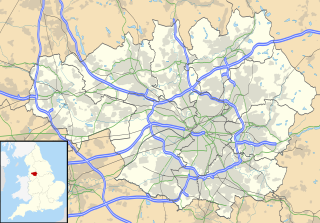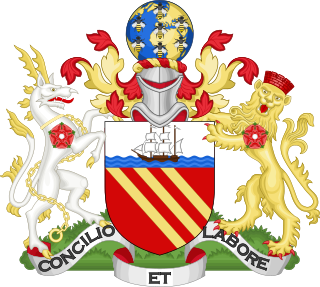Smedley is an area of north Manchester, England, on the banks of the River Irk between Cheetham Hill to the west, Collyhurst to the south, Crumpsall to the north and Harpurhey to the east. [1]

Manchester is a major city and metropolitan borough in Greater Manchester, England, with a population of 545,500 as of 2017. It lies within the United Kingdom's second-most populous urban area, with a population of 2.7 million, and third-most populous metropolitan area, with a population of 3.3 million. It is fringed by the Cheshire Plain to the south, the Pennines to the north and east, and an arc of towns with which it forms a continuous conurbation. The local authority for the city is Manchester City Council.

England is a country that is part of the United Kingdom. It shares land borders with Wales to the west and Scotland to the north. The Irish Sea lies west of England and the Celtic Sea to the southwest. England is separated from continental Europe by the North Sea to the east and the English Channel to the south. The country covers five-eighths of the island of Great Britain, which lies in the North Atlantic, and includes over 100 smaller islands, such as the Isles of Scilly and the Isle of Wight.

The River Irk is a river in North West England that flows through the northern suburbs and towns of Greater Manchester.
In 1819, Samuel Bamford and Henry Hunt stopped at Smedley Cottage, before the Peterloo Massacre, and the Middleton contingent to the demonstration passed by it on their way into Manchester via Collyhurst Road. [2] In the novel The Manchester Man by Isabella Banks, the titular character, Jabez Clegg, is swept in infancy into the River Irk at Smedley Vale.

Samuel Bamford, was an English radical reformer and writer born in Middleton, Lancashire. He wrote in and on the subject of northern English dialect.

Henry "Orator" Hunt was a British radical speaker and agitator remembered as a pioneer of working-class radicalism and an important influence on the later Chartist movement. He advocated parliamentary reform and the repeal of the Corn Laws.

The Peterloo Massacre took place at St Peter's Field, Manchester, Lancashire, England on Monday 16 August 1819 when cavalry charged into a crowd of 60,000–80,000 who had gathered to demand the reform of parliamentary representation.
Theresa Yelverton, a party to the Yelverton case, lived as a child at Merryfield House, at the corner of Queens Road and Smedley Road, overlooking the Irk Valley. [3]

Theresa Yelverton was an English woman who became notorious because of her involvement in the Yelverton case, a 19th-century Irish law case, which eventually resulted in a change to the law on mixed religion marriages in Ireland.
The Yelverton case was a famous 19th-century Irish law case, which eventually resulted in a change to the law on mixed religion marriages in Ireland.
In the early 1930s, Kennet House, a development of modernist flats, was built in Smedley. [4] In 2019, a new footbridge across the Irk opened, linking Smedley to Collyhurst. [5]

Modern architecture, or modernist architecture was based upon new and innovative technologies of construction, particularly the use of glass, steel and reinforced concrete; the idea that form should follow function (→functionalism); an embrace of minimalism; and a rejection of ornament. It emerged in the first half of the 20th century and became dominant after World War II until the 1980s, when it was gradually replaced as the principal style for institutional and corporate buildings by postmodern architecture.

















